A good way of explaining LVT is through a series of diagrams showing how land values arise from the first settlement of virgin territory through its evolution to a large community, and the best example of this is the settlement and development of North America. The column diagrams that follow show the economic growth of a community from very simple beginnings, where each column represents the productivity on each site. All real wealth derives from work, physical or mental, and in the earliest settlements this was almost exclusively due to agrarian work applied directly to the land.
Figure 1 represents the productivity of the first site settled and worked by one man and his family. The settler has an abundance of choice from equally fertile sites and the column represents the maximum production he can achieve to support himself and his family on the site he selects.
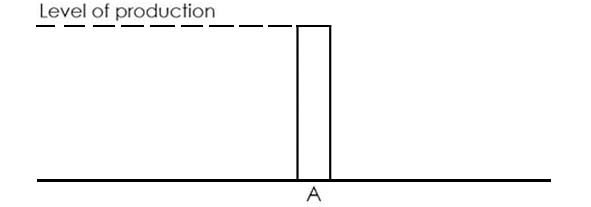 Fig. 1
Fig. 1
 Fig. 2
Fig. 2
Figure 2 shows two further sites settled and worked with similar results, giving a general level of productivity by settlers working independently on sites of similar fertility, assuming equality of work done by each settler. In reality although the sites may well be physically adjacent, as they are worked independently, they are shown as separate in the diagram.
 Fig. 3
Fig. 3
In figure 3 two of the settlers decide that it is mutually beneficial to work in co-operation to effect what neither would be able to do alone. Their total combined product is therefore more than twice the product of each working separately. This additional product may be described as a co-operative surplus. The decision of A and B to co-operate is the first step in the creation of an economy. Economics begins with and depends on interaction. This principle is fundamental to any understanding of LVT––the idea of co-operation is paramount. Economics as such begins at this point, when men co-operate to act collectively. When the three settlers were operating independently an economic community had not come into being. When A and B agreed to co-operate an economic relationship was established.
 Fig. 4
Fig. 4
In Figure 4 settlers C and D have joined the embryonic community and the overall product increases accordingly. It is reasonable to assume that the settlers will choose what they see as the best sites, which may be described as ‘prime sites’. At this stage it can be seen that the production on each site is equal, and the original production level, common to all sites, becomes a useful reference datum to maintain through the subsequent diagrams.
Each new settler is naturally attracted to join the existing community and with each addition the co-operative surplus increases with greater efficiency through more specialisation (generally described by economists as ‘the division of labour’). In this simple community the distribution of the surplus product would be shared equally for equal work done; as yet there are no taxes. Neither is there any need for money, for after all how could it be spent? Whatever transactions take place, are in kind, or the exchange of labour. The level of this co-operative production rises with each new member of the community but is still the same for all sites, which are of equal productivity. At this stage the growing community is still characterised by equality: of work done, production achieved, distribution of benefits and values of the respective sites.
When the prime sites are all taken the next settler will have to take a site that is less productive (in agrarian terms), a so-called marginal site (site E, Figure 5). However his production will still be superior to that which he could achieve independently. He will receive the benefit from the co-operative surplus as well as contributing towards it. His independent production level is shown (theoretically) as lower than that of the production of the original prime sites. Marginal sites will be occupied and worked as long as they provide the occupant with a viable living and where the product is more than could be achieved working independently.
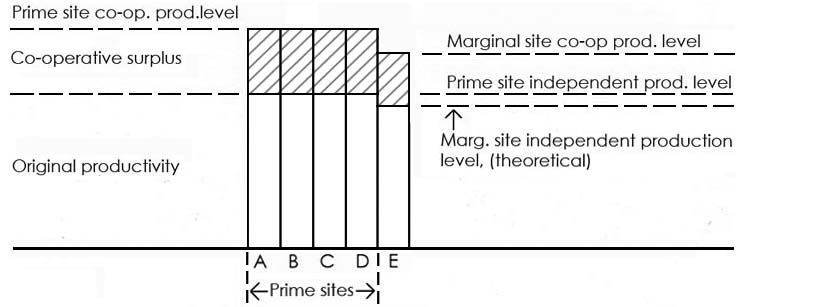 Fig. 5
Fig. 5
The level of production at the margin will, in later development, become an important factor in the economic arrangement. The appearance of the margin has created the first manifestation of a differential in land values, albeit due to the reduced value of site E. However, this difference is largely caused by the physical condition of site E within an agrarian economy, due for instance to reduced fertility or the lack of a natural water source. It is site E itself that is different, nothing has changed on the prime sites. The apparent advantage of the prime sites is due to the disadvantage of site E. The theoretical marginal-site independent production level is shown in the diagram for the sake of comparison.
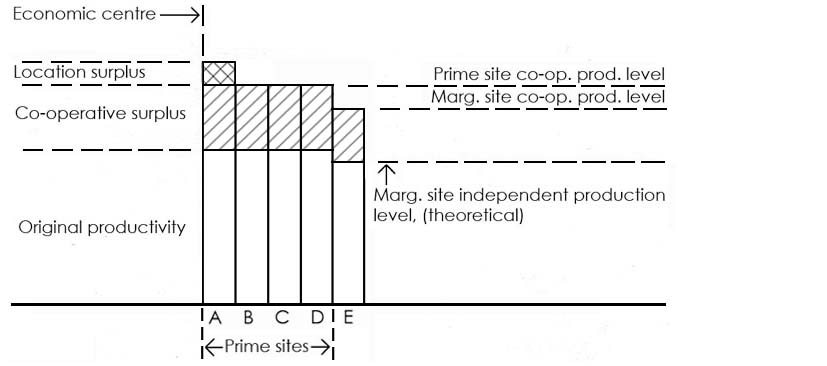 Fig. 6
Fig. 6
Figure 6 shows the next phenomenon––positive advantage due to location.
At the same time as more marginal sites are occupied, adding to the co-operative surplus, a positive difference in productive advantage arises on certain sites due entirely to their location in relation to all the others. Though no increase of work on the sites has taken place they will become more productively advantageous due to their proximity to the centre of economic activity. They may not necessarily be at the geographic centre of the community, but rather at the economic centre, perhaps where the community chooses to hold a market, or where a crossroads arises. In Figure 6, site A shows this additional productivity, that may be termed a location surplus, and it is this surplus that provides the principal justification for a land value tax. This location surplus introduces a second differential in land values, which has a different cause to the first. The first is due to decreased fertility, an act of nature, the second is a man-made phenomenon, due to the existence and growth of a community. It is this second type of differential that will be the future basis for LVT. Certainly the manifestation of location value would appear on the prime sites first as they would already be at the centre of the community. This would be due to their positive advantage of location and have little to do with any advantage of fertility.
The community as it grows will, for whatever reason, naturally form an economic centre of gravity, and those that benefit from this will do so by the simple good fortune of their location. It is this fact of location that will outweigh all others as an advantage as a community grows to eventually become a large city. The important point to acknowledge is that this increase of value is not due to any particular activity on the site itself, but to the collective activity of all the sites as an economic whole. One may say that this collective activity gives rise to a centripetal economic pressure. This pressure causes certain sites to become more valuable within a community the nearer they are to the economic centre.
The foregoing is a description in principle of how differential land values arise. This same principle holds good throughout the subsequent development of the small community into a great thriving metropolis with very high land values. Nothing in this process changes the principle that these differential values are created by the whole community, and, for that reason, may be considered a proper source for taxation.
With continuing growth the community transforms from a mainly agrarian to a more commercial urban base, and the more valuable sites are at the centres of commerce and trade. In our simple early community a general store might be established on what is seen as the most advantageous location, followed by a hotel and other amenities, so consolidating the establishment of an economic centre. Each new arrival adds to the overall prosperity increasing the pressure on the more valuable sites and thereby increasing the location surplus (see Figure 7).
 Fig. 7
Fig. 7
It must be remembered that these diagrams are useful only to explain the principles involved. In reality a community is a living dynamic organism, which evolves on all fronts at the same time. As will be shown later, the datum provided by the original agrarian prime site level will eventually be replaced by the datum of the marginal level, from which the location surplus will thereafter be measured.
Up to this point the diagrams have been based on the growth of a fundamentally agrarian society. However the more a society grows the more it transforms its basic activities to commerce and trade. The measure of productivity, and therefore the value of a site, will move away from considerations of fertility and proximity to the market to more commercially based criteria. The economic centre will move to where the action is; for example the construction of a bridge may provide a new centre for trade. Sites previously considered marginal may well become more valuable because of their location, and this is the nub of the matter: location is all-important. The previous significance of agrarian prime site production diminishes as society moves to commerce and trade. However the basic causes of the co-operative surplus and the location surplus do not change.
As the community grows, productivity increases on all sites, but the increase is now due to commercial rather than agrarian activity. In this transformation to urban development, the prime sites A, B, C and D, will be favoured; production now being more a question of profitability for the occupier in whatever form that can be achieved.
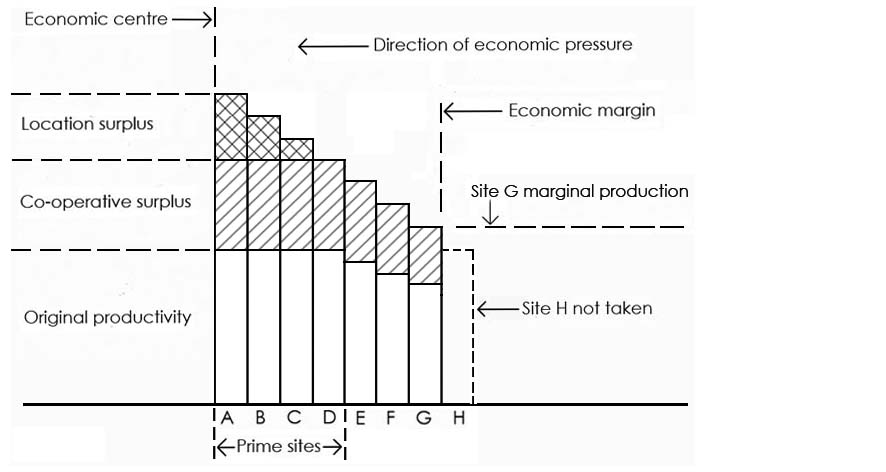 Fig. 8
Fig. 8
Figure 8 shows an even gradation of differential values from the highest production on site A to the newest marginal site G. Where marginal sites are freely available, the prospective occupier will be free to decide for himself whether to exploit the site on his own account or work for another for wages. (The subject of wages will be discussed later, together with employment and the issue of speculation).
As the community develops the productivity due to agricultural activity remains relatively static, whereas that due to commercial activity increases on all sites.
In Figure 9, when site H is finally taken it will be because the productivity is more than the occupant can achieve outside the community. It is still worthwhile for any newcomer to join the prospering community and to benefit from the co-operative surplus. Figure 9 shows continuing growth where sites A,B,C and D are all showing locational advantage, for commercial reasons, whereas their original agrarian production level remains the same. The agrarian based levels of production have by now become completely overtaken by the commercial levels, and the new margin is at a higher level than the original productivity of the prime sites.
 Fig. 9
Fig. 9
So far in the diagrams the agrarian levels of production have been useful in explaining how the co-operative surplus arises as an integral part of the economic process but in the new commercial situation the agrarian criteria become increasingly redundant and are shown in Figure 9 purely for theoretical comparison. For clarity they will be omitted from figure 10 onwards, where only the commercial margin level will be used as the new datum. Henceforth the diagrams are based on urban rather than agrarian values. This datum line now becomes the level from which to measure values due to location. From this point onwards it is the level of production at the margin that will provide the reference base for further economic development, in particular relating to the issues of wages, employment and speculation. However it has to be remembered that all production below the level due to location always comprises an element due to co-operation. All communities depend on co-operation and interaction if they are to prosper. Although it may not be readily apparent it is always there; it is the glue that holds a community together and provides the future foundation for location values.1 Interaction also includes competition as well as co-operation. This is shown where certain activities and trades group together for mutual benefit but still remain in competition.
Wages and Employment
From the very earliest stages of development, on the more productive sites, an occupant may decide that it is more profitable to employ labour to carry out the work. To attract the labour the wages offered will need to be higher than an individual can achieve working independently on a marginal site. This level of wages will therefore be related to the alternative level of earnings at the margin. The level of wages offered will depend on the supply and demand of labour. Where labour is scarce the level will rise above the marginal site level; where it is abundant it will tend to fall below, and new marginal sites will be occupied in preference. In general, where land is freely available these levels will tend to track each other (see Figure 10).

Fig. 10 Wages, where land is freely available
Where land is not freely available (due to enclosure or prior claims to ownership) the prospective settlers will be forced to seek their fortune elsewhere or work for wages at a depressed level.
Tenancy
In the early years of settlement in North America the settlers were simply squatters on land previously used freely by the Native Americans who had no concept of land ownership. The settlers staked out as much land as they could use and proceeded to work it. Over time, due to their responsible occupation, their appropriation went unchallenged and became quasi-ownership through custom and usage. Their claim to ownership was, no doubt helped by the ideas of the political philosopher John Locke––that work carried out on the land was a justification for ownership (see Part 3, item 2, Ownership of Land). Their efforts towards ownership were also helped by pre-emption laws that allowed them to buy small areas of land at minimum prices.2 On the more productive sites owner/occupiers could choose to employ labour directly or rent all or part of their land to a tenant, who paid a rent out of his earnings from the land he worked. The rental value to the owner was thus related to the productive value of the site. It is this annual rental value of land that is later to become the preferred basis for calculating the rate of LVT.
Land Speculation
The US Federal government was always interested in encouraging the settlement and development of territory westward. To this end, in 1785, it introduced an ordinance in which lots of 640 acres of land could be sold off at $2 an acre.3 Unfortunately this opportunity was exploited by land speculators who had no intention of working the land themselves. They bought up large selective areas which they then held out of use, waiting for values to rise so they could make a good profit from renting or selling later at a higher price. This of course prevented new settlers from gaining access to viable sites. An even lower margin was thus created beyond the enclosed land held out of use, which further depressed the level of wages. (see Figure 11)
 Fig. 11 Wages depressed by land speculation.
Fig. 11 Wages depressed by land speculation.
The speculators were able to make great fortunes selling off individual sites at high profits as the land values rose with increasing demand. This type of speculation continues to this day and is especially damaging in newly developing countries.
In a fully developed community the site values would range from the minimum at the margin to the maximum at the economic centre. In reality the differences in values are always steeper towards the economic centre and more gradual towards the margin. Figure 12 has been drawn to show this distinction, where the closer one approaches the centre the greater are the differences, whereas sites towards the margin, which are more numerous, will have differences that progressively diminish.
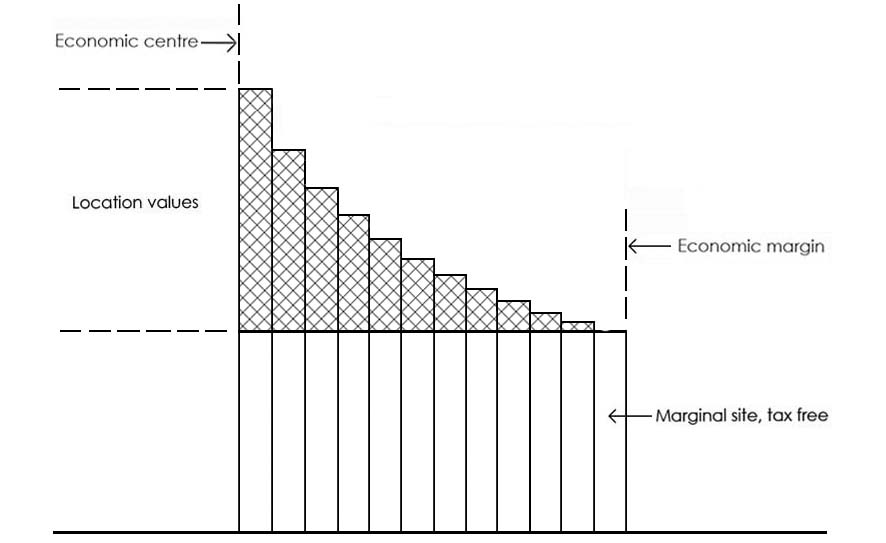 Fig. 12
Fig. 12
All communities will develop an economic centre, which will arise naturally with any economic activity, not necessarily near any geographic centre, but nevertheless fairly well defined within a limited area. On the other hand the economic margin will be less well defined, being determined simply by the decision of any potential occupier as to whether the return achievable on any site is worthwhile, compared to the alternative of working for wages, or trying another community altogether.
In later development a large city may have numerous local centres as well as a principal centre with the highest site values. Low-value sites may occur anywhere between these centres but the true margin of activity will be at the periphery of the whole agglomeration. Within a developing community the economic centre will not be fixed either in character or position. An earlier centre may well be overtaken by another centre related to other activities, but one thing they will all have in common is that the communal demand to occupy the sites will determine their value.
It is worth noting that within a typical concentric form of growth, valuable sites at the centre are few, whereas sites at the margin are numerous. Also, as was shown earlier, the least productive sites at the margin contribute to the value of the sites at the centre. As LVT is to be taken only from above the level of the margin it is clear that the marginal site, by definition, would always be tax-free.
References:
(1) The economic margin and land value differentials were first described by David Ricardo in his ‘Principles of Political Economy and Taxation’ of 1817
(2) For an excellent example of contemporary infrastructure co-operation refer to video: ‘The Bridge at Q’eswachaka’
(3) Sparknotes: http://www.sparknotes.com/history/american/westwardexpansion/section2.rhtml